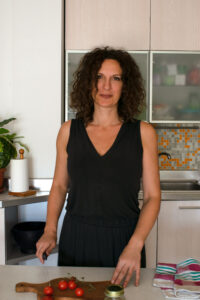Master Homemade Puff Pastry Without Special Equipment (VIDEO)

Learn how to make flaky, buttery puff pastry from scratch using simple kitchen tools. Our easy recipe guides you through the folding and layering process for perfect homemade puff pastry.
Have you ever dreamed of creating flaky, buttery puff pastry at home without investing in expensive equipment? You’re not alone. Many home bakers assume crafting this delicate dough requires specialized tools or years of culinary training. However, with the right technique, you can master homemade puff pastry using just your hands and a rolling pin. In this article, you’ll discover a foolproof method for producing bakery-quality puff pastry without a stand mixer. By following these simple steps, you’ll unlock the secret to achieving hundreds of gossamer-thin layers that puff up dramatically in the oven. Get ready to elevate your baking game and impress friends and family with your newfound pastry prowess.
How to Make Puff Pastry Dough From Scratch Without a Stand Mixer
Creating homemade puff pastry without special equipment is a rewarding culinary adventure. While it requires patience and elbow grease, the result is a flaky, buttery pastry that rivals any store-bought version.
Watch the Video Tutorial
Gathering Your Ingredients for Homemade Puff Pastry
Before you begin, ensure you have high-quality butter, flour, salt, and cold water on hand. The key to perfect homemade puff pastry lies in using very cold butter and maintaining cool temperatures throughout the process. Here are the ingredient for about 1400 g of puff pastry (about 3 pounds):
- 250 ml cold water (1 cup plus 1 tbsp)
- 650 g Tipo 00 flour OR all-purpose flour (5⅓ cups plus 1 tbsp) + more for dusting
- 12 g sea salt (2 tbsp)
- 165 g diced butter, softened (1¼ sticks plus 1 tbsp)
- 400 g diced butter, very cold (3½ sticks)
The Mixing Process
Start by combining flour, salt, and a portion of softened butter in a large bowl. Mix these ingredients by hand, then add the remaining cold butter. The goal is to create a shaggy dough with visible butter pieces, which will later form the signature layers.
Folding and Resting
The magic of puff pastry happens during the folding and resting stages. Roll out your dough, then fold it to create layers. This process, known as “turning”, is repeated several times, with resting periods in between to allow the gluten to relax. With each turn, your homemade puff pastry becomes smoother and more uniform, developing its characteristic flaky texture.
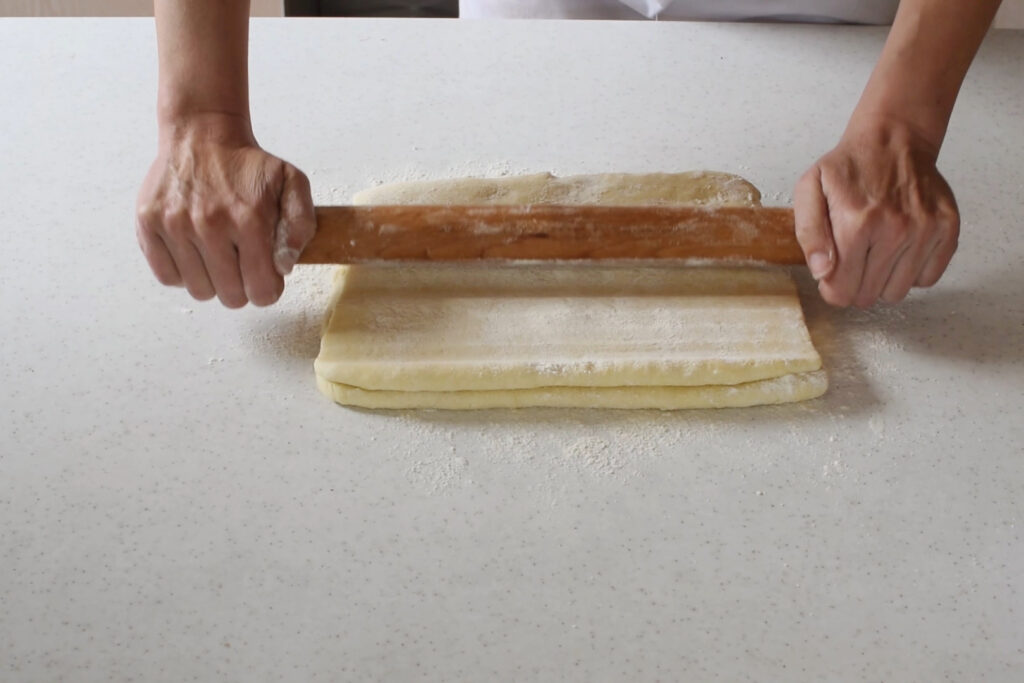
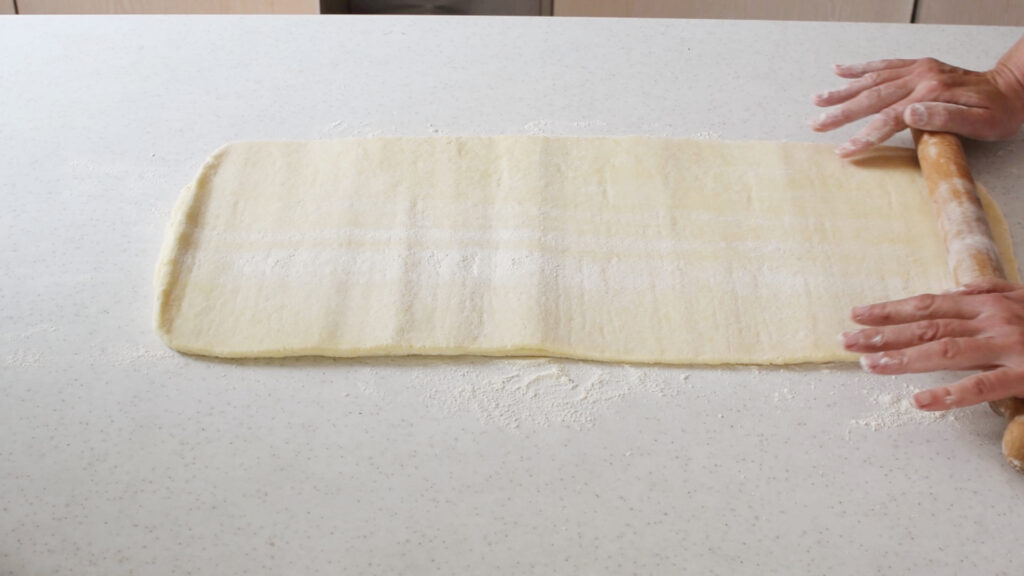
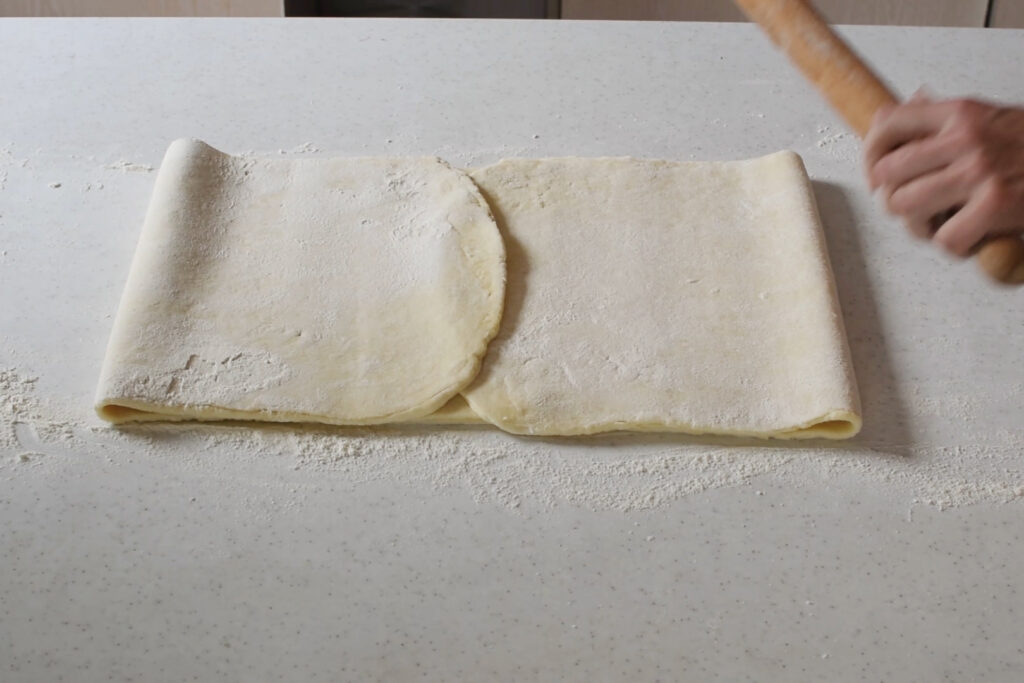
Folding and Layering Techniques for Flakiness
Creating the perfect homemade puff pastry requires mastering the art of folding and layering. This technique, known as lamination, is crucial for achieving those delicate, flaky layers that make puff pastry so irresistible.
The Basics of Lamination
Start by rolling out your dough into a rectangle. Fold the short ends towards the center, overlapping them to create three layers. This is called a single fold or letter fold. After each fold, rotate the dough 90 degrees before rolling it out again.
Advanced Folding Methods
For even more layers, try the book fold. Roll out the dough, fold both short ends to the center without overlapping, then fold the dough in half like closing a book. This creates four layers in one go.
Tips for Perfect Layers
Always chill the dough between folds to keep the butter cold. This prevents it from melting into the flour layers, ensuring distinct, flaky layers in your final homemade puff pastry. With practice, you’ll be creating bakery-worthy pastries in no time!
Baking and Serving Your Homemade Puff Pastry Creations
Now that you’ve mastered making puff pastry from scratch without a stand mixer, it’s time to put your creation to delicious use. Preheat your oven to 200 °C (400 °F) for most puff pastry recipes. For best results, chill your shaped pastries for 15–30 minutes before baking to help maintain their form.
Baking Tips
When baking your homemade puff pastry, avoid opening the oven door frequently, as this can cause uneven rising. Brush the top with an egg wash for a golden sheen. Bake until the pastry is puffed and golden brown, typically 15–25 minutes depending on size and filling.
Serving Suggestions
Let your baked goods cool slightly before serving to allow the layers to set. Homemade puff pastry shines in both sweet and savory applications.
This homemade puff pastry was used to make cream-filled cannoli and appetizers for a party last weekend. The guests were thrilled! So if you’ve always wanted to make homemade puff pastry without splurging on a mixer, you must try this simple method. Just follow the steps, and before you know it, you’ll be rolling out puff pastry like a pro. Try this no-mixer method — the results are sure to impress.
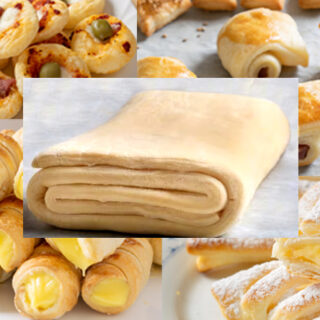
Master Homemade Puff Pastry Without Special Equipment
Ingredients
- 250 ml cold water
- 650 g Type 00 flour OR all-purpose flour + more for dusting
- 12 g sea salt
- 165 g diced butter softened
- 400 g diced butter very cold
Instructions
- Combine water, flour, salt, and softened butter in a large bowl. Knead for 1 minute with your hands to partially incorporate the ingredients.
- Add the very cold butter and knead for another minute with your fingertips, without warming the mixture, just to form a ball. At this stage, the butter will not be fully mixed in, and some butter pieces will still be visible.
- Transfer everything to a work surface and dust with flour. Roll out into a rectangle about 50 cm long and 7-8 mm thick. Fold the two short ends towards the center, overlapping them to create 3 layers. This forms the first layering.
- After each fold, rotate the dough 90 degrees before rolling it out again. Dust with flour and press it a little with the rolling pin to widen the rectangle.
- Roll it out again from the open end, trying to form a rectangle that is thinner and thinner than the previous one. Fold the two short ends towards the center without overlapping. Finally, fold the dough in half to create 4 layers. This completes the second layering.
- Cover with plastic wrap and refrigerate for 1 hour.
- Remove from the refrigerator and roll out again from the open end, dusting with flour. Fold like the second layering. This creates the third layering. The dough will become smoother and more uniform.
- Rotate the dough 90 degrees and roll out again. Fold into quarters like the second layering.
- Cover with plastic wrap, and refrigerate for at least 2 hours.
- After the refrigeration period, your homemade puff pastry is now ready to use in your recipes!




